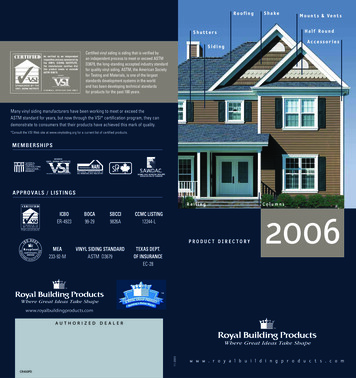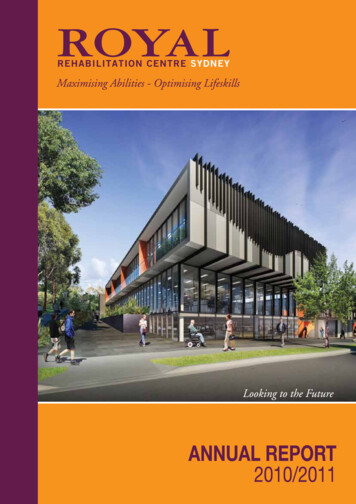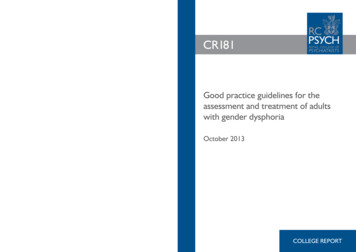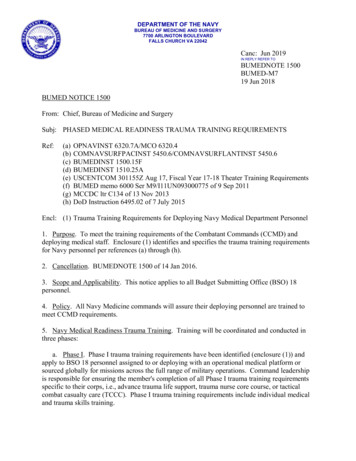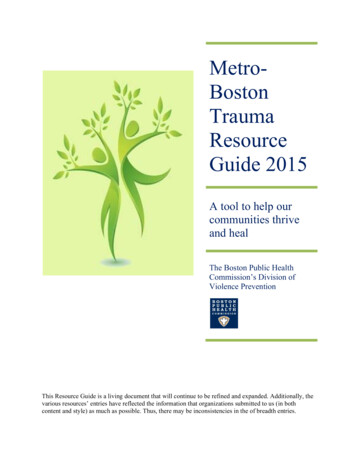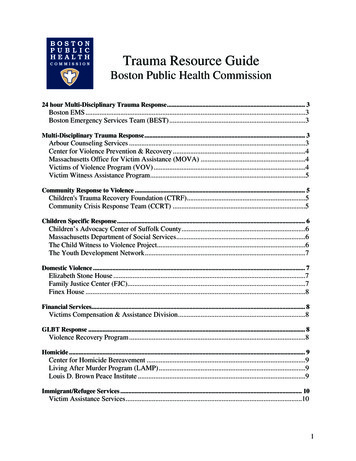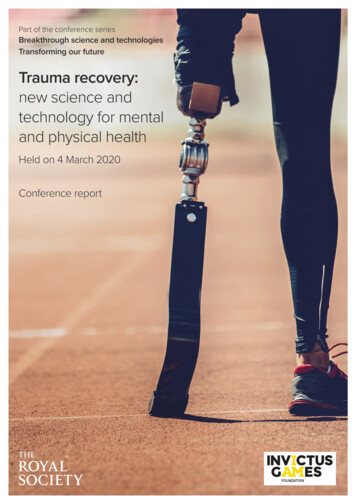
Transcription
Part of the conference seriesBreakthrough science and technologiesTransforming our futureTrauma recovery:new science andtechnology for mentaland physical healthHeld on 4 March 2020Conference reportTrauma recovery: new science and technology for mental and physical health – Conference report 1
IntroductionOn 4 March 2020, the Royal Society held an international conference in partnership with theInvictus Games Foundation to explore recent innovations in the field of trauma science andrecovery. This is an area of vital concern in which new technologies and treatments havethe real potential to improve the lives of those affected by trauma in the near future. Themeeting brought together leading experts from industry, academia, the military, healthcareand the wider scientific community, as well as those who have experienced trauma.The programme was shaped by Professor Russell FosterCBE FRS (University of Oxford), Professor Jackie HunterCBE (BenevolentAI) and Sir Simon Wessely FMedSci(King’s College London). The day focused on two broadthemes: our increased understanding of the humanbiology of mental and physical health following trauma,and the application of innovative new technologies andinteractions with industry to help individuals adapt tolife-changing injuries. At a private reception following theconference, speakers gave interactive demonstrations –from virtual reality environments used to treat mentalhealth disorders to best-in-class prosthetics – to guestsincluding Prince Harry, Duke of Sussex and patron of theInvictus Games Foundation.This conference is part of a series organised by the RoyalSociety entitled Breakthrough science and technologies:Transforming our future, which addresses the majorscientific and technical challenges of the next decade.Each conference covers key issues including the currentstate of the UK industry sector, the future direction ofresearch and the wider social and economic implications.The conference series is organised through the RoyalSociety’s Science and Industry programme whichdemonstrates the Society’s commitment to integratescience and industry across its activities, promote scienceand its value, build relationships and foster translation.This report is not a verbatim record, but a summary of thediscussions that took place during the day and the keypoints raised. Comments and recommendations reflectthe views and opinions of the speakers and notnecessarily those of the Royal Society.Image: Delegates networking at the conference.Trauma recovery: new science and technology for mental and physical health – Conference report 2
Executive summaryConference speakers explored a range of developments, from the results of large-scalecohort studies to robotics for rehabilitation and direct neural control of prosthetics.Key topics included: The effects of trauma on mental and physical health; T echnology to rehabilitate and recover from mentaland physical trauma; and C ritical areas of scientific focus to drive forwardinnovations.Key themes: T echnological and healthcare developments for traumarecovery within the military bring significant benefit tothe wider civilian population. R ecent neural science advances are leading to greatercontrol of prosthetics and freedom for amputees. V irtual Reality is an incredibly powerful tool in thetreatment of mental health disorders. Greaterinvestment in VR by technology companies has led toaccelerated innovation in this space. T raumatic Brain Injury and Post-Traumatic Stress Disordershare symptoms and are often misdiagnosed. Greaterinvestment and research are needed to diagnose andtreat the conditions correctly and efficiently. S leep is an overlooked and critical factor in therecovery of mental health disorders caused by trauma.New treatments and initiatives can help individuals withvisual impairments and patients on acute trauma wardsto regulate their sleep and regain emotional andphysiological health. W hile there is great momentum and funding to developnew treatments during times of conflict, there is a needto maintain this in times of peace so that we are betterplaced to help veterans in the future.Image: Dame Sue Ion FREng FRS, Chair of the Royal Society Science,Industry and Translation Committee, welcoming guests to the Royal Society.This optimistic conference demonstrated examples ofwhere the impact of trauma has been mitigated andblunted. Sectors must work in concert to consider whatcan be achieved in the short and medium term (periodsof years not decades), how to drive these achievementsforward and how to prioritise based on the experiencesof those who have suffered traumatic injury in order todrive forward change for the better. When combined,science, engineering, motivation, courage and hopehave the power to transform lives.“ While injury and trauma are facts of life, trauma need not be a life sentence. I’m convinced thatthe impossible is genuinely being transformed tangibly into the possible, and individuals whohave suffered mental and physical injury can achieve the almost limitless potential of the humanspirit. The Royal Society is committed to promoting science for the benefit of humanity, and incollaboration with the Invictus Games Foundation has truly achieved this today.”Professor Russell Foster CBE FRS, University of Oxford.Trauma recovery: new science and technology for mental and physical health – Conference report 3
Trauma recovery: group studies andpersonal perspectivesThe ADVANCE Study: study rational and preliminary cardiovascular resultsThe ADVANCE Study (ArmeD SerVices TrAuma RehabilitatioN OutComE) is the firstprospective study to investigate the long-term physical and psychosocial outcomes ofbattlefield casualties related to recent armed conflict in 2002-2014. Professor ChristopherBoos, Poole Hospital NHS Foundation Trust, described the study’s initial findings.Historical and retrospective data suggest an associationbetween combat-related traumatic injury and an increasedrisk of cardiovascular disease (CVD). While Americanamputees in World War Two displayed increased CVD riskif they had proximal opposed to distal limb amputations,inconsistent results were found from a literature reviewregarding the link between trauma-induced amputationand CVD. This could be because the study used a controlgroup of healthy civilians, instead of veterans. TheADVANCE Study seeks to rectify this, providing acontemporary study with prospective data and a properlyconstructed control group.The ADVANCE cohort study aims to recruit 1,200 adultmale UK military service personnel following deploymentto Afghanistan between 2002 and 2014. The cohort will besplit with 600 individuals who sustained significant combatrelated injuries matched to 600 non-injured adults bydeployment, age, sex, service, rank and role, with outcomesmeasured over 20 years. The study seeks to understandthe physical and psychosocial outcomes from Afghaninjured service personnel to find the best possible caregoing forward, including pre-emptive measures to reducethat risk and help people move into society when leavingarmed services. The study is nearing the end of recruitmentwhich should be completed within the next six months.Image: Professor Christopher Boos, Poole Hospital NHS Foundation Trust.“ We hope to use the knowledge gained tohelp support and plan the best possible carefor our injured service personnel, so that if wedo identify areas of increased vulnerability,we can take preventative measures to reducethat risk and improve society as a whole.” rofessor Christopher Boos, Poole Hospital NHSPFoundation Trust.Trauma recovery: new science and technology for mental and physical health – Conference report 4
The general hypothesis is that combat-related traumaticinjury leads to a high level of co-morbidities, poor longterm quality of life and mental health, as well as poorfunctional, social and employment outcomes.A further hypothesis of the study is that combat-relatedtraumatic injury leads to an increased Cardiovasculardisease risk. This risk will be measured in the participantsby assessment of their blood lipid and high sensitivity CRP(marker of chronic inflammation) levels, body mass index,blood pressure, heart rate variability and arterial stiffness.Arterial stiffnessArterial stiffness is an important independent predictor ofadverse cardiovascular events, cardiovascular mortality,all-cause mortality and stroke. Stiffer arteries are less ableto buffer the hydrostatic effects of blood leaving the heartand lead to an increase in blood pressure and fasterblood flow. Our hypothesis is that lower limb amputationleads to an increased cardiovascular risk profile andearlier reflection of the forward travelling arterial wavefrom the heart. This earlier wave reflection leads toaugmentation and increase in central blood pressurewhich is a risk factor for stroke and other adversecardiovascular events.ResultsPreliminary cardiovascular risk data is presented on thefirst 845 consecutive participants. In the study, data iscompared for the 453 non-injured participants and 392with combat-related traumatic injury, which consists of 273with traumatic injury without amputation (TIWA) and 119with lower limb amputations. Key initial results fromamputees include: Higher hip and waist circumferences than non-amputees. L owest HDL cholesterol (good cholesterol) in individualswith proximal amputations versus distal amputations andversus TIWA and non-injured service personnel. H igher levels of glycated haemoglobin, a markerfor diabetes. H igher creatinine clearance, indicating that kidneysare working overtime. H igher heart rate in amputees than TIWA andnon-injured groups. L ower subendocardial viability ratio (SEVR) – an indirectmarker of coronary blood flow in amputees. H igher HsCRP levels (a marker of chronic systemicinflammation and a known Cardiovascular risk)among amputees.This is the first study to identify increased biomarkers ofsubclinical CVD risk among amputees with recent combatrelated traumatic injury. There are consistent early signalsamong amputees versus non-injured service personnel,including greater visceral fat, greater relative vascularinflammation, lower HDL cholesterol and lower SEVR.No change is observed in arterial stiffness or bloodpressure at this stage, but the above changes precedepotential future changes in arterial stiffness. The reasonfor these differences could include more sedentarylifestyle, greater occurrence of post-traumatic stressdisorder (PTSD), or testosterone deficiency in amputees.The observed cardiometabolic changes feed intohaemodynamic changes, which in turn lead to diseasesuch as stroke and heart attack.Trauma recovery: new science and technology for mental and physical health – Conference report 5
The principles of (recovering from) warRecovering from the realities of traumatic injury is a long, complicated and often painfulprocess. However, just as warfare has been optimised, so should recovery. Afghanistanveteran and scientist Dave Henson MBE, Imperial College London, offered his personalperspective of recovering from war.“ Everything is long-term: there is no recovered,it’s all recovery. We need to ensure thatthe resources available to those who needrecovery are sustainable and long-term.”Dave Henson MBE.Henson’s training in science and the military has beenessential in guiding his recovery. Following anundergraduate degree in mechanical engineering with ayear in the army and a dissertation in adaptive supports fordisabled veterans, Henson joined a commissioning coursein Sandhurst and subsequently the Royal Engineers,fulfilling his teenage dream of being in the army. As anupsurge troop in Afghanistan, Henson complemented theUK’s counter-IED taskforce: improvised explosive devices(IEDs) had been the leading cause of injury for all troops inAfghanistan. Unfortunately, while clearing a compound ofIEDs Henson stood on a device disguised by recent rain,requiring a bilateral amputation of his legs.Recovery through sportThe recovery pathway can and should be optimised,and there is a role for new technologies and treatmentswithin this process. Determined to leave the army withthe same physical fitness with which he entered it, sportformed a critical part of Henson’s recovery. He wasselected to be Captain of the British team in the inauguralInvictus Games, winning gold in the 200m sprint, andwent on to win bronze in the 200m at the 2016 ParalympicGames. For Henson, this represented a transition frombeing an injured serviceman to being someone who alsohad a present and a future.Optimising recovery with the principles of warThe components of fighting power (figure 1) used todescribe the capability of the armed forces can be applieddirectly to recovery. Combined with the principles of war, aplanning tool for prompt and effective use of the availableresources, these enabled Henson to optimise andstructure his recovery within a familiar framework.The principles of war as applied to recovery are: S election and maintenance of aim – essential inany recovery. M aintenance of morale – including family and peersupport groups going through rehabilitation in a similarsituation: as soon as Henson was in hospital he wasvisited by other amputees. O ffensive action – action over reaction, takingownership of situation and dictating what to do with it. Security – weighing up risk and reward and takinga risk to push a person forward. Surprise – seizing the initiative and taking advantageof all opportunities. C oncentration of force and economy of effort –balancing and prioritising your resources to understandwhere your main effort lies and allocate appropriateresource to move forward. F lexibility and cooperation – work with your supportproviders, such as your physiotherapist, to moveforward and take their advice. Sustainability – ensure that there are enoughresources to last for a lifetime’s recovery.Innovation forms another key component of militarycapacity. Henson highlighted key innovators in therecovery space, thanking them and suggesting them asgroups to turn to: Stanford Hall; Combat Stress; Help forHeroes; Blesma, The Limbless Veterans; Battle Back;The US Department of Defence Warrior Games; TheEndeavour Fund; and The Invictus Games Foundation.He looks forward to future work by the University ofBirmingham, JHUB, Imperial College Centre for BlastInjury Studies, The ADVANCE Study, and CASEVAC club.Trauma recovery: new science and technology for mental and physical health – Conference report 6
Image: Dave Henson MBE, Imperial College London.FIGURE 1The capability of armed forces is often described using ‘Fighting Power’, comprising conceptual, moral and physicalcomponents. Image courtesy of Dave Henson.MoralCohesionMotivationLeadershipFighting powerPhysicalConceptualResourcesPrinciples of warSustainabilityDoctrineConceptual innovationReadinessCollective performanceTrauma recovery: new science and technology for mental and physical health – Conference report 7
New treatments for sleep and mentalhealth disordersIntroductionA circadian rhythm is a natural, internal process that regulates the sleep-wake cycle. ProfessorRussell Foster CBE FRS, University of Oxford, explained how traumatic injury to the eyes canprofoundly affect sleep and disrupt circadian rhythm. The suprachiasmatic nucleus (SCN) is thebrain’s ‘master clock’, which dictates the timing of hormone release, emotions, behaviours andthe sleep cycle. This is set to the external world by detecting the light-dark cycle – jetlagoccurs due to the mismatch of external daytime with the internal world.If an individual suffers major eye damage, this clockcannot be set to the external world and they drift awayfrom the light/dark cycle. Circadian rhythm disruptionharms a person’s emotional, cognitive and physiologicalhealth as the individual becomes ‘out of sync’ with theday/night cycle and becomes socially isolated, which canfurther exacerbate trauma-related symptoms. The threedomains of health that are affected are as follows: Emotional: anxiety, loss of empathy, use of stimulantsand sedatives, negative salience, risk taking, impulsivityand illegal drug use. Cognitive: impaired performance, memory, attention,communication, motor performance, decision makingand dissociation. Physiological: CVD, altered stress response, alteredsensory thresholds, cancer, lowered immunity, type IIdiabetes, depression and psychosis.This understanding provides two treatment options:1. E ye damage that renders an individual visually blind, dueto the loss of rods and cones, may preserve the pRGCs.In such cases, appropriate light treatments (includingseeking out enough natural light to regulate sleep-waketiming) can be used to restore a sense of time.2. B ased upon an understanding of how the pRGCsregulate the circadian system, drugs are beingdeveloped that can ‘fool’ the body clock that it hasseen light. These new drugs will be used to restoresleep/wake timing in individuals who have lost theireyes and will soon be tested with Blind Veterans UK.This offers the hopeful message that visual blindnessneed not result in circadian blindness in humans.Yet there is hope: sleep and circadian rhythm disruptionpresents a therapeutic target for new drugs. Foster’s workhas shown that in addition to the rods and cones thatprovide us with our sense of vision, there is a third groupof light sensitive cells in the eye known as photosensitiveretinal ganglion cells (pRGCs) which regulate our circadianrhythms and set the body clock to the outside world.Image: Professor Russell Foster CBE FRS, University of Oxford.Trauma recovery: new science and technology for mental and physical health – Conference report 8
How to sleep well – understanding the causes and cures for a bad night after traumaNormal quantity and timing of sleep is critical for normal brain function including mood,memory and metabolism. This makes sleep a key tool for recovery after a physical or mentalhealth problem. Dr Kirstie Anderson, Newcastle-upon-Tyne Hospitals NHS Foundation Trust,explained how technology can be used to help people have better nights.Impact of sleep disturbance on brain functionTesting memory and cognition in a patient population withbipolar disorder showed that the patients perform as wellas individuals without bipolar disorder, provided they havenormal sleep. It is therefore important to protect sleep,especially in hospital wards where patients are particularlyvulnerable to mental health problems, such as the acutetrauma ward.Causes of poor sleep after trauma“Sleep disturbance” is not a diagnosis. To be treatedeffectively, the distinct and treatable sleep disorders mustbe properly defined as one of the following: Hypersomnia: excessive sleepiness - struggling to stayawake during the day; Insomnia: inability to fall and/or stay asleep most nightsfor longer than three months with daytime impact; Parasomnia: abnormal behaviours while sleeping,including nightmares, sleepwalking, night terrors; C ircadian rhythm disorder: desynchronisation of internalsleep-wake rhythms and the external light-dark cycle.Effective digital and psychological therapiesThe STOPbang questionnaire can be used to screen forthose at high risk of obstructive sleep apnoea – thisaffects 20-30% of the population with severe or enduringmental health problems compared to 5% of the generalpopulation. Digital technologies now provide anempowering solution for patients, for example remoteCPAP monitoring and a phone app to treat the pauses inbreathing can restart normal sleep and help peopleto resume normal life.It is common practice to prescribe for daytime diseasesbut forget the impact of drugs on night sleep, for exampleneuropathic pain medication and opioids have a negativeimpact on sleep quality and obesity. While drugs are ofvalue, psychological therapies have historically beenundervalued. Image rehearsal therapy is a simple buthighly effective therapy used to treat chronic nightmaresincluding in those with PTSD, improving PTSDsymptomatology and sleep quality.Cognitive Behavioural Therapy for insomnia (CBTi) isnow the recommended first approach for insomnia inboth the UK and the US and is effective for treatinginsomnia. The therapy has been digitised to allow greateraccess to all including the NHS approved platformsSleepstation and Sleepio.Ensuring good sleep in hospital beds is a key part ofrecovery. The SleepWell pilot study within the acutein-patient psychiatry wards across Newcastle found thatreducing hourly night observations by nurses significantlyimproved sleep quality, with a 23% decrease in use ofhypnotics and a decrease in mental health issues such asdeliberate self-harm. “ If sleep is a tool for recovery, then one placewhere we should protect sleep is the acutetrauma ward environment.” r Kirstie Anderson, Newcastle-upon-Tyne HospitalsDNHS Foundation Trust.Image: Dr Kirstie Anderson, Newcastle-upon-Tyne HospitalsNHS Foundation Trust.Trauma recovery: new science and technology for mental and physical health – Conference report 9
Knowledge for the benefit of Blind Veterans and wider humanityMajor General (Rtd) Nick Caplin, Blind Veterans UK, expanded on the devastating physicaland mental effects of sight loss. Blind Veterans UK researches factors to maintain andimprove quality of health and social inclusion, while accelerating innovation.Loss of sight is both physically and mentally challengingand leads to a plethora of difficulties at different stages oflife. Research by Blind Veterans UK seeks to enablebeneficiaries to maintain and improve the quality of theirhealth and well-being, their level of social inclusion andtheir satisfaction with life. As well as social wellbeing,Blind Veterans UK focuses on biomedical research andtechnological innovations. Focused evaluation hasdirected three of their main key areas for research: Sleep Traumatic brain injury (TBI); and D evelopment of autonomous vehicles for disabledindividuals.SleepCollaboration with Professor Russell Foster CBE FRSseeks to better understand circadian disruptionexperienced by blind veterans. In the area of sleep,80% of veterans report poor sleep and shortened sleep(average 5.7 hours) along with significant poor healthand a 41% risk of mental health disorders, predominantlydepression and anxiety. New treatment options toimprove sleep are being developed for the veterans.Traumatic Brain InjuryDue to the physical proximity, any traumatic eventinjuring the eye is likely also to have affected the brain.The symptoms of PTSD and TBI are remarkably similar(figure 2), including confusion, memory deficits, moodchanges and insomnia. However, the diagnosis givenby a GP depends on whether the GP knows if that personis a veteran: if they do, they go down the mental healthroute, which may not be the correct avenue, if not, theyare likely to follow a neurological treatment route.Another focus of research is to understand linksbetween brain injury and sight loss. Age-related maculardegeneration is observed decades before expected dueto TBI. Research seeks to uncover whether sight loss isrelated to a TBI event long before, or a series of brainevents with cumulative impact.“ Our work clearly is all about discovering newknowledge for the benefit of blind veteranstoday and tomorrow – and for a broaderpopulation as well.”Major General (Rtd) Nick Caplin, Blind Veterans UK.Image: Major General (Rtd) Nick Caplin, Blind Veterans UK. Dr Tom Zampieri, President of the Blinded Veterans Association and Mr Bryan Naylor, a memberof Blind Veterans UK, took part in the Q&A session.Trauma recovery: new science and technology for mental and physical health – Conference report 10
FIGURE 2Credit: Hussain et al., submitted.Autonomous vehicles98% of blind veterans want to drive again and regain theirindependence, and this is acting as a major initiative for BlindVeterans UK to accelerate development of new autonomousvehicles. An autonomous pod has been developed inconjunction with the self-driving vehicle company Aurrigoand is being trialled in Blind Veterans UK’s Brighton centrewith over 400 visually impaired participants.Bind Veterans UK’s research is detailed and wide-ranging,working internationally with the Blinded Veterans ofAmerica and following veterans over their lifetime. Whilethis rich data resource focuses on the needs of ex-soldiers,the knowledge and new treatment options will not onlybenefit blind veterans today and tomorrow but will informhealth and wellbeing in the broader visually impairedpopulation and general society.Trauma recovery: new science and technology for mental and physical health – Conference report 11
Using Virtual Reality (VR) to deliver engaging, efficacious, and fastpsychological interventionVirtual Reality (VR) can help to deliver effective psychological interventions rapidly. Mentalhealth disorders are very common, but far too few people receive the best treatments.Professor Daniel Freeman, University of Oxford, posited that delivering automatedtreatments in VR can help provide the best possible evidence-based psychologicaltreatments to large numbers of individuals – within a safe virtual environment.Using VR simulations, individuals can repeatedlyexperience problematic situations and be taught how toovercome difficulties via evidence-based psychologicaltreatments. VR technologies have progressed significantly,and investment by major technology companies hashelped it become accessible to the public.Key advantages of VR include: T he potential to automate provision of psychologicaltherapy without a real-world therapist. T reatments can be made more compelling, rewardingand interactive compared to traditional therapies. E ffective, expert, personalised psychologicalinterventions can be digitised and automated, allowingconsistent rollout to more patients such as through thegameChange1 project for schizophrenia. A wareness of the patient that a computer environmentis not real, but their minds and bodies behave as thoughit is. People will much more easily face difficult situationsin VR than in real life and be able to try new therapeuticstrategies that they can then bring into the real world.VR treatment of fear of heightsPsychological therapy can be hugely powerful for treatingmental health problems: after 2.5 hours of VR therapy, apatient’s fear of heights was treated so that he was ableto stand on a balcony. The success of VR treatmentrequires a clear linkage between the problem, in thiscase fear of height, and the individual’s rationale to dealwith it. The VR therapy aims to build new thoughts aboutheight, developing a curious attitude, dropping defencesand overriding the old fear response.Image: Professor Daniel Freeman, University of Oxford.The University of Oxford has developed a six-sessionautomated treatment with a virtual therapist and usercentred design, including VR avatars animated and voicedby actors to maximise lifelikeness. The patient can choosewhich VR scenarios to enter, and with each entry the taskbecomes harder. The platform is halfway through arandomised controlled trial involving 432 patients withpsychosis, looking at outcomes including real worldperformance and anxiety in certain situations.“ All mental health problems play out inday-to-day situations – for example, beingby heights for acrophobia, being aroundalcohol for alcohol disorders, and beingaround people for social anxiety. The besttherapy is active: going into the troublingsituations and helping people think, feeland behave differently.”Professor Daniel Freeman, University of Oxford.VR treatment of psychosisA large-scale clinical trial seeks to use VR to treat the clinicaltarget for psychosis, social withdrawal: 65% of psychosispatients demonstrate extreme levels of avoidance.1. www.gameChangeVR.comTrauma recovery: new science and technology for mental and physical health – Conference report 12
Innovations in the treatment of post-traumatic stress disorderProfessor Barbara Rothbaum, Emory Healthcare Veterans Program, is exploring howto increase the efficacy of Cognitive Behavioural Therapy (CBT) for trauma. This utilisesvirtual reality exposure therapy, intensive outpatient therapy, exposure therapy combinedwith pharmacological cognitive enhancers, and early treatment immediately afterexposure to trauma.Virtual Reality Exposure TherapySymptoms of PTSD are part of the normal response totrauma, and treatments have traditionally included: C BT: the patient is reminded of trauma in a therapeuticmanner so that the relationship to trauma changes,including physical changes in the brain and body. P rolonged Exposure (PE) Therapy: a kind of CBT inwhich patients repeatedly recount their traumaticexperience aloud and listen to it, thereby confrontingsafe reminders of the trauma. This has more evidenceof efficacy than any other approved PTSD treatment.Virtual Reality Exposure Therapy (VRE) is a new methodto deliver exposure therapy. This combines imaginalexposure with a VR environment mimicking a patient’sdescription to create a sense of presence for the user,such as in a war zone, on a plane to treat fear of flying,or around drug users to treat addiction. VRE was foundto be effective for PTSD following initial use with Vietnamveterans, and is now being used worldwide to treattrauma survivors. With increased computing power,graphics are more lifelike and offer the flexibility to adjustparameters such as the time of day, room configurationand sounds within a scene.Enhancing Exposure Therapy withpharmacological agentsIn a novel application, the efficacy of VRE can beenhanced by combining it with cognitive enhancers suchas the old antibiotic D-Cycloserine (DCS). In this treatment,VRE is underdosed but preceded by a pill which enhancesthe learning. A decrease in PTSD symptoms (such asacoustic startle and salivary cortisol reactivity) is observedin
Trauma recovery: new science and technology for mental and physical health - Conference report 6 The principles of (recovering from) war Recovering from the realities of traumatic injury is a long, complicated and often painful process. However, just as warfare has been optimised, so should recovery. Afghanistan
